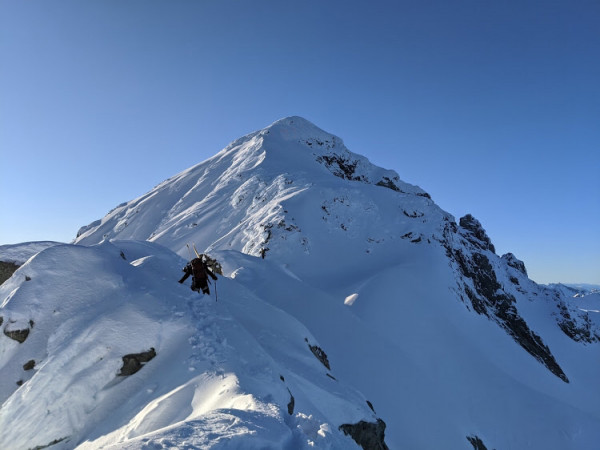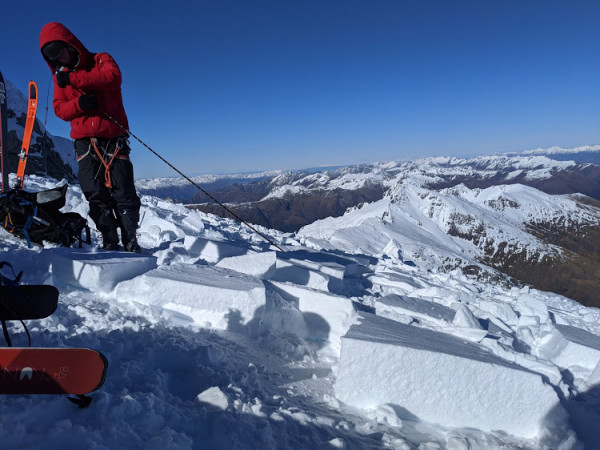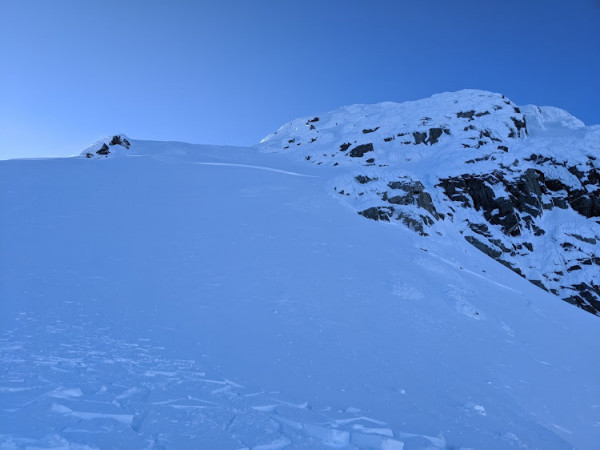A personal quest for avalanche awareness | Owen's story
Miscalculations and poorly based decisions while on the mountain can be enough to change one's perspective on safety.
For Owen Daniell, this rings true as he reflects on a “terrifying” avalanche incident while ski mountaineering two years ago in Mt Aspiring National Park. It has triggered his quest for better avalanche education and awareness.
Owen recalls the clear, blue sky on the August day in 2020, “it was a beautiful, clear day with no wind or anything, and the snow was looking really nice. But really, the scene was set up for complacency,” he says.
He and a few friends were heading up to Brewster Glacier and Mt Armstrong via Brewster Hut for the weekend.
“We got up early and we were going to try and ski off Brewster. One of the other guys was going climbing near there, so we thought we’ll go have a ski and have fun.”

The group of five had just met that weekend, all with varied alpine skills. Based in Christchurch but originally from Oregon, United States of America, Owen was still learning the ways of New Zealand’s mountains, hoping to learn more from the group.
They headed up Brewster Glacier, then to the south-west ridge, just taking in the sweeping views of surrounding mountains while feeling stoked they had lucked out on such a good weather window.
Looking to make the most of the bluebird day, some were keen to explore before skiing the descent.
“Me and my mate were forging ahead, and we found this ledge on the southeast side of the ridge, maybe 50 metres below it, so we thought we’d stash our gear here, go check out the summit, then come back and ski the nice bowl below.
“At this point it's just so cool - we were kind of caught up in the moment, using our hearts not our heads,” he says.
“But right before we crested the ridge, I stuck my ice axe in and a crack shot out, maybe 3 to 5 metres sideways, releasing a 10cm thick hard wind slab.
“As soon as I saw it I yelled ‘avalanche’, which alerted my mate who was on the ledge; he dove onto his ice axe so he didn’t get swept up.
Owen was then scooped up by the size 1 avalanche as it came out from under him.
“There wasn’t enough depth to get really sunk down into as it was a bunch of 10cm blocks sliding at the same level, and I was among them.
“But I thought, ‘I’m going to die’..."
Then the avalanche slowed, and the two landed on the ledge amongst their gear in a moment of pure relief.
“Had I gone off the ledge, I probably would have gone a good way down the snowslope onto the glacier.”
Thankfully no one was injured.

In the time since the incident, Owen has reflected on the avalanche decisions and discussions the group should’ve had before and during the trip.
“There were a few instances where I was like ‘we didn’t think about it at all’.”
We saw avalanche debris on our approach to the face, but attributed it to the serac above, not snowpack instability, he said.
“It wasn’t even like we kind of thought about it, discussed it and decided it was okay, it was that we didn’t think about it at all and then just sleep-walked into it really. That was the biggest thing I think.”

Owen also said the size of the party and each members alpine skills played into his thinking on the day.
“Part of my mind was if the more experienced weren’t worried about it then I don’t need to be.
“We were a big party, so I felt decision making was rather difficult. It was also a bit like not wanting to slow the group down, not wanting to be a party pooper,” he recalled.
“Those were the things that kept me from looking [for avalanche signs] as much as I should of,
it played heavily into the confirmation and continuation bias, that and the whole blue sky-syndrome complacency.”
Knowing the potentially fatal results of an avalanche, Owen has been motivated by his “terrifying” experience and continuing mountain ambition to further upskill in his avalanche safety knowledge. He has recently completed his American Avalanche Institute Pro 1 certificate.
Owen believes that avalanche courses are an important baseline of knowledge, because “you’re only going to learn so much going out with your mates”.
Owen’s tips to those wanting to step up their avalanche experience and knowledge:
- Take an avalanche course and apply the learnings to every trip.
- Debrief: go over all decision making and critique yourself.
- Have a proper framework and thought process for when you’re in an emotional, potentially scary and exciting mountain environment. Having a process that you can work through in your mind is important.
- Discuss decision making processes with people who have more experience.
- Clearly Define group goals. Choose an objective based on what every member of the group wants out of the trip.
The NZAA has launched a new ‘Aspiring’ forecast region for 2022 which now includes the Brewster region.
Thanks for sharing your story with us Owen, every experience in the mountains provides opportunities to learn and sharing these can help others learn too. If others have a story to share, they are welcome to get in touch with us at the NZ Mountain Safety Council.
Stay safe this winter
- Read our other story from another adventurer
- Find the forecast for your destination
- Kickstart your avalanche awareness
Header: Post avalanche perspective. PHOTO/SUPPLIED
Photo 1: The view before the avalanche, looking up the South West ridge. PHOTO/SUPPLIED
Photo 3: The group among the blocks of windslab. PHOTO/SUPPLIED
Photo 4: A view of the Crown Wall and the aftermath. PHOTO/SUPPLIED